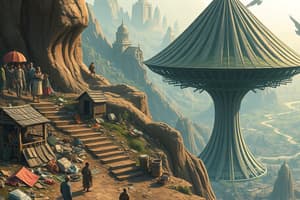Podcast
Questions and Answers
According to Carneiro (1970), what is a defining characteristic of a state?
According to Carneiro (1970), what is a defining characteristic of a state?
- Reliance on kinship ties for governance.
- A political unit encompassing multiple communities with a centralized government that can enforce laws and collect taxes. (correct)
- A small, egalitarian society without formalized leadership.
- Absence of social stratification.
What is the significance of an 'office' in the context of political systems like chiefdoms and states?
What is the significance of an 'office' in the context of political systems like chiefdoms and states?
- It is primarily responsible for religious ceremonies and has little impact on governance.
- It is a role assigned based on individual skills rather than lineage or social status.
- It is a temporary position of authority that ends when the current holder dies.
- It is a permanent position of authority that exists independently of the person who occupies it, ensuring socio-political continuity. (correct)
In chiefdoms, how is social status primarily determined?
In chiefdoms, how is social status primarily determined?
- Through demonstrating superior skills in warfare and conquest.
- Based on seniority of descent from common ancestors. (correct)
- Through individual achievements and acquired wealth.
- Through a lottery system that assigns status randomly.
What distinguishes social stratification in states from that in chiefdoms?
What distinguishes social stratification in states from that in chiefdoms?
Which action is most characteristic of the role of chiefs in the context of resource management within a chiefdom?
Which action is most characteristic of the role of chiefs in the context of resource management within a chiefdom?
What is the key outcome of 'stratum endogamy' in state societies?
What is the key outcome of 'stratum endogamy' in state societies?
According to Weber, which of the following dimensions contribute to social stratification?
According to Weber, which of the following dimensions contribute to social stratification?
How do social stratification dimensions (wealth, power, prestige) differ between chiefdoms and early states?
How do social stratification dimensions (wealth, power, prestige) differ between chiefdoms and early states?
Which of the following societal evolutions is generally observed as economies become more productive, according to the text?
Which of the following societal evolutions is generally observed as economies become more productive, according to the text?
In archaic states, how did fiscal systems contribute to social stratification?
In archaic states, how did fiscal systems contribute to social stratification?
Based on the provided information, what is a key distinction between tribes and chiefdoms in terms of regulatory structure?
Based on the provided information, what is a key distinction between tribes and chiefdoms in terms of regulatory structure?
In foraging bands, how are status differences primarily determined?
In foraging bands, how are status differences primarily determined?
Which of the following is a key function of population control within archaic states?
Which of the following is a key function of population control within archaic states?
Which of the following is a characteristic of regulatory officials in tribal societies?
Which of the following is a characteristic of regulatory officials in tribal societies?
How do state laws differ from the social norms in non-state societies?
How do state laws differ from the social norms in non-state societies?
What distinguishes prestige from formal authority in the context of social regulation?
What distinguishes prestige from formal authority in the context of social regulation?
What role does the judiciary play in maintaining the social order of archaic states?
What role does the judiciary play in maintaining the social order of archaic states?
How do states alter the importance of kinship compared to bands, tribes, and chiefdoms?
How do states alter the importance of kinship compared to bands, tribes, and chiefdoms?
Which economic type is most associated with state sociopolitical organization?
Which economic type is most associated with state sociopolitical organization?
How do foraging bands typically handle conflict resolution?
How do foraging bands typically handle conflict resolution?
Which of the following best describes the relationship between violence and the formation of states?
Which of the following best describes the relationship between violence and the formation of states?
What is a key difference between the regulatory systems of chiefdoms and states?
What is a key difference between the regulatory systems of chiefdoms and states?
How do archaic states typically manage their populations through administrative divisions?
How do archaic states typically manage their populations through administrative divisions?
What distinguishes the elite stratum in archaic states from the subordinate stratum?
What distinguishes the elite stratum in archaic states from the subordinate stratum?
Which of the following best describes the key difference between power and authority?
Which of the following best describes the key difference between power and authority?
According to Morton Fried's definition, what is the primary focus of political organization?
According to Morton Fried's definition, what is the primary focus of political organization?
Which of the following characteristics distinguishes a chiefdom from a tribe, according to Elman Service's typology?
Which of the following characteristics distinguishes a chiefdom from a tribe, according to Elman Service's typology?
In bands and tribes, the political order is often described as 'embedded'. What does this mean?
In bands and tribes, the political order is often described as 'embedded'. What does this mean?
Kottak uses the term 'sociopolitical organization' rather than 'political organization' when discussing bands and tribes. Why?
Kottak uses the term 'sociopolitical organization' rather than 'political organization' when discussing bands and tribes. Why?
Which type of sociopolitical organization is most commonly associated with horticulturalist and pastoralist societies?
Which type of sociopolitical organization is most commonly associated with horticulturalist and pastoralist societies?
A society primarily based on agriculture is most likely to develop which form of sociopolitical organization?
A society primarily based on agriculture is most likely to develop which form of sociopolitical organization?
Which of the following scenarios would be considered an example of 'power' rather than 'authority'?
Which of the following scenarios would be considered an example of 'power' rather than 'authority'?
In tribal societies, what is the primary basis for achieving status?
In tribal societies, what is the primary basis for achieving status?
What is a key distinction between a village head and a "big man" in terms of authority?
What is a key distinction between a village head and a "big man" in terms of authority?
How do Kapauku cultivation techniques differ from those of the Yanomami, and what is the result of this difference?
How do Kapauku cultivation techniques differ from those of the Yanomami, and what is the result of this difference?
Which of the following best describes how a village head typically exercises their influence?
Which of the following best describes how a village head typically exercises their influence?
In what way does the Kapauku big man's economic status differ from that of a Yanomami village head?
In what way does the Kapauku big man's economic status differ from that of a Yanomami village head?
What is the primary way a "big man" in South Pacific societies, such as the Kapauku, achieves and maintains their position?
What is the primary way a "big man" in South Pacific societies, such as the Kapauku, achieves and maintains their position?
What distinguishes chiefdoms from tribes as forms of sociopolitical organization?
What distinguishes chiefdoms from tribes as forms of sociopolitical organization?
What is the role of the village head when disputes arise?
What is the role of the village head when disputes arise?
Flashcards
Power
Power
The ability to exercise one's will over others.
Authority
Authority
The socially approved use of power.
Political Organization
Political Organization
Aspect of social organization that relates to managing public policy.
Bands
Bands
Signup and view all the flashcards
Tribes
Tribes
Signup and view all the flashcards
Chiefdom
Chiefdom
Signup and view all the flashcards
State
State
Signup and view all the flashcards
Sociopolitical Organization
Sociopolitical Organization
Signup and view all the flashcards
Foraging Economy
Foraging Economy
Signup and view all the flashcards
Foraging Social Groups
Foraging Social Groups
Signup and view all the flashcards
Prestige
Prestige
Signup and view all the flashcards
Egalitarianism in Bands
Egalitarianism in Bands
Signup and view all the flashcards
Tribal Regulatory Officials
Tribal Regulatory Officials
Signup and view all the flashcards
Horticultural Economy
Horticultural Economy
Signup and view all the flashcards
Tribal Leadership
Tribal Leadership
Signup and view all the flashcards
Tribal Egalitarianism
Tribal Egalitarianism
Signup and view all the flashcards
Village Head
Village Head
Signup and view all the flashcards
Big Man Status
Big Man Status
Signup and view all the flashcards
The "Big Man"
The "Big Man"
Signup and view all the flashcards
Kapauku Cultivation
Kapauku Cultivation
Signup and view all the flashcards
Big Man's Wealth (Kapauku)
Big Man's Wealth (Kapauku)
Signup and view all the flashcards
State (definition)
State (definition)
Signup and view all the flashcards
Office (in political systems)
Office (in political systems)
Signup and view all the flashcards
Chiefdom (resource role)
Chiefdom (resource role)
Signup and view all the flashcards
Chiefdom social status
Chiefdom social status
Signup and view all the flashcards
Social Stratification
Social Stratification
Signup and view all the flashcards
Stratum Endogamy
Stratum Endogamy
Signup and view all the flashcards
Status differences (chiefdoms and states)
Status differences (chiefdoms and states)
Signup and view all the flashcards
Weber's dimensions of social stratification
Weber's dimensions of social stratification
Signup and view all the flashcards
Superordinate Stratum
Superordinate Stratum
Signup and view all the flashcards
Subordinate Stratum
Subordinate Stratum
Signup and view all the flashcards
State Population Control
State Population Control
Signup and view all the flashcards
State Laws
State Laws
Signup and view all the flashcards
State Judiciary
State Judiciary
Signup and view all the flashcards
State Law Enforcement
State Law Enforcement
Signup and view all the flashcards
State Fiscal System
State Fiscal System
Signup and view all the flashcards
State Administrative Divisions
State Administrative Divisions
Signup and view all the flashcards
Study Notes
- SSF 1044 examines the Introduction to Anthropology & Sociology, focusing on Power and Politics.
- Aristotle stated in Politics, 350 B.C. that "Man is by nature a political animal".
Power vs Authority
- Power is the ability to exercise one's will over others.
- Authority is the socially approved use of power.
Political Organization
- Political organization is an aspect of social organization.
- Political organization encompasses portions of social organizations that specifically relate to individuals or groups that manage public policy affairs or seek to control individual or group activities.
Typology of Political Organizations
- In 1962, anthropologist Elman Service developed a typology of political organizations.
- Bands consist of small, kin-based groups found among foragers.
- Tribes are linked to non-intensive food production, having villages and/or descent groups without formal government or social classes.
- A chiefdom is a sociopolitical organization intermediate between tribe and state, kin-based, with a lasting political structure and differential resource access.
- The state is identified by its formal government and social classes.
- In bands and tribes, political order (polity) is not an isolated institution but included within the social order as a whole.
- Kottak prefers the term sociopolitical organization when discussing cross-cultural similarities and differences because it is more inclusive.
Sociopolitical Types and Economy
- There are correlations between economy and sociopolitical organization.
- Foragers often have band organizations.
- Horticulturalists and pastoralists tend to have tribal organizations.
- Agriculturalists tend to have either chiefdom-level or state-level organizations.
- More productive economies typically lead to increased population sizes, leading to greater regulatory problems and more complex social and political structures.
Sociopolitical Types and Economy Table:
- Band: Foraging, local regulation, Inuit, San
- Tribe: Horticulture and pastoralism, local and temporary regulation, Yanomami, Nuer, Kapauku
- Chiefdom: Horticulture, pastoral nomadism, agriculture, permanent regional regulation, Qashqai, Cherokee, Polynesia
- State: Agriculture and industrialism, permanent regional regulation, Ancient Mesopotamia, modern United States and Canada
Foraging Bands
- Bands are represented by small, kin-based groups, where members are linked by kinship or marriage ties.
- In foraging societies, the nuclear family and the band are the only two significant social groups.
- Membership in these groups can change from year to year.
- Kin networks are created and maintained through marriage, trade, and visiting.
- Foraging bands are egalitarian, and status differences are achieved.
- Foragers do not have formal law; and conflict resolution is part of kinship and social ties.
- Prestige is respect or approval.
Tribal Cultivators
- Tribes generally maintain a horticultural or pastoral economy, organized by village life and/or descent-group membership.
- Social classes and formal government are absent in tribes.
- Small-scale warfare or inter-village raiding is not uncommon.
- Key officials include village heads, "big men," descent-group leaders, village councils, and leaders of pantribal associations.
- These officials have limited power, and lead through persuasion and example.
- Like foragers, tribes are egalitarian.
- Horticulturalists are egalitarian and typically live in low-density villages.
- Egalitarianism decreases as village size and population density increase.
The Village Head
- Horticultural villages usually have headmen (rarely, headwomen).
- An example is the Yanomami of is in the Amazon region in Brazil and Venezuela.
- Village heads secure their positions but have restricted authority with its position.
- They cannot force or coerce people and can only persuade and influence via their generosity.
- Village heads serve as mediators in disputes, but have no authority to enforce decisions or punishments.
The "Big Man"
- A big man has regional authority, influencing multiple villages,.
- The big man is common to the South Pacific.
- Among the Kapauku, in Irian Jaya, Indonesia, the big man, is the only political figure outside the household.
- Their position (prestige) and is achieved through generosity, eloquence, bravery, physical fitness, and supernatural powers.
- Decisions made by the big men are binding among followers.
- They regulate regional events like feasts and markets.
- Kapauku cultivation involves techniques for specific land types.
- Labour-intensive cultivation in valleys involves mutual aid and is organized by the "big man".
- Kapauku cultivation sustains a denser population compared to the Yanomami.
- Big men's wealth surpasses villagers, unlike Yanomami village heads.
Chiefdoms and States
- Chiefdoms are a sociopolitical organization between tribes and states and act as an intermediary stage.
- Carneiro defined (1970) the state as a self-governing unit comprising multiple communities, possessing a centralized government with the power to tax, draft individuals for labor or military service, and enact and enforce laws.
- Examples include archaic/nonindustrial states and industrial/modern states.
Chiefdoms
- Chiefdoms and states differentiate from bands and tribal systems.
- Their offices last beyond their occupants.
- An office is a permanent position of power separate from its occupant,.
- It continues when vacated by the previous occupier.
- Offices ensures the continuity of the sociopolitical organization.
- Chiefs facilitate production, distribution, and consumption of resources.
- They gather tribute and redistribute foodstuffs at feasts.
Chiefdoms: Social Status
- In chiefdoms, social status depends on seniority of descent.
- All chiefdom residents are descendants of common ancestors.
- Proximity to founding ancestors determines prestige.
- Chiefdoms feature a prestige continuum from the chief to lower-ranked individuals.
- Chiefs are senior descendants and have knowledge of genealogy.
Chiefdoms and States: Social Status
- Status distinctions in chiefly and state societies differ from tribal and band organizations.
- State and chiefdom status systems are based on differential and wealth access.
- States have clearer class divisions with stratum endogamy.
- Social stratification and distinct social classes are key state markers.
Social Stratification
- Weber's dimensions of social stratification include:
- Wealth or economic status.
- Political status on power.
- Social status centered on prestige.
- In chiefdoms, all three dimensions are related to kinship and descent.
- Early states first revealed distinctions across these dimensions between endogamous groups.
Social Status in Archaic States
- In ancient states and their were two basic class distinctions::
- The superordinate stratum of elites had preferential access to resources.
- The subordinate stratum comprised the underprivileged.
States: Specialization
- States have specialized units.
- Population control involves defining boundaries, citizenship, and census taking.
- Judiciary systems establish laws, legal procedure, and judges.
- Enforcement involves military and police forces.
- Fiscal matters concern with taxation.
- These subsystems are embedded in archaic ruling systems.
States: Population Control
- States governments use administrative divisions to oversee populations.
- Administrative divisions are managed by state representatives.
- States usurp the role of kinship within bands, tribes, and. chiefdoms.
- States promote mobility and resettlement.
- States differentiate rights across statuses such as:
- Citizens against non-citizens, etc.
- Elites against commoners and slaves, etc.
- Soldiers compared to civilians.
States: Judiciary
- State codified behavior differs from non-state traditions.
- Governments oversee family situations.
- Law presence has not reduced violence.
States: Enforcement
- A judicial system requires enforcement.
- Enforcement protects internal and external conflict and state structures.
States: Fiscal Systems
- State leadership completes not subsist.
- Rulers depend on members for resources.
- Fiscal practices in archaic countries enhanced status of elite.
Studying That Suits You
Use AI to generate personalized quizzes and flashcards to suit your learning preferences.




